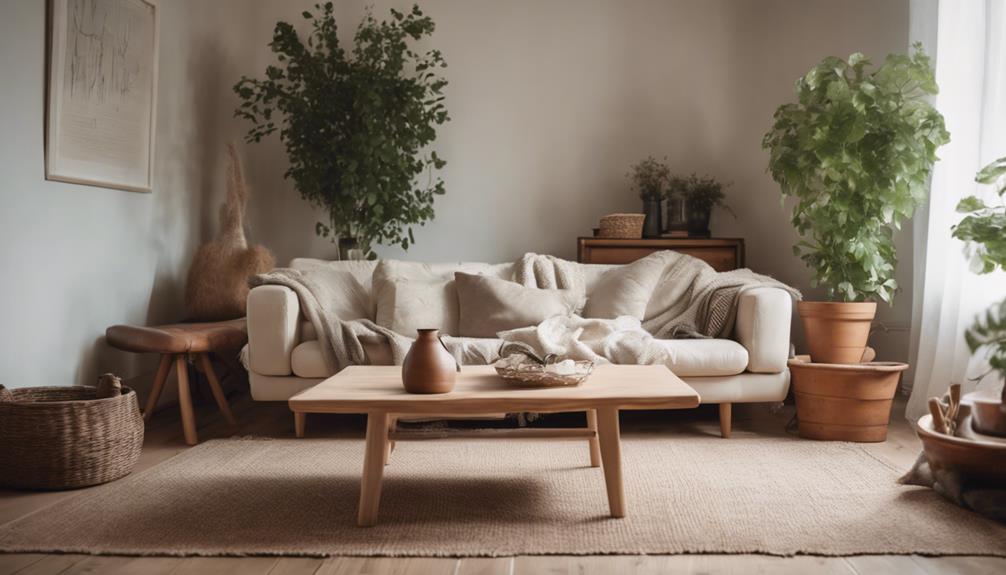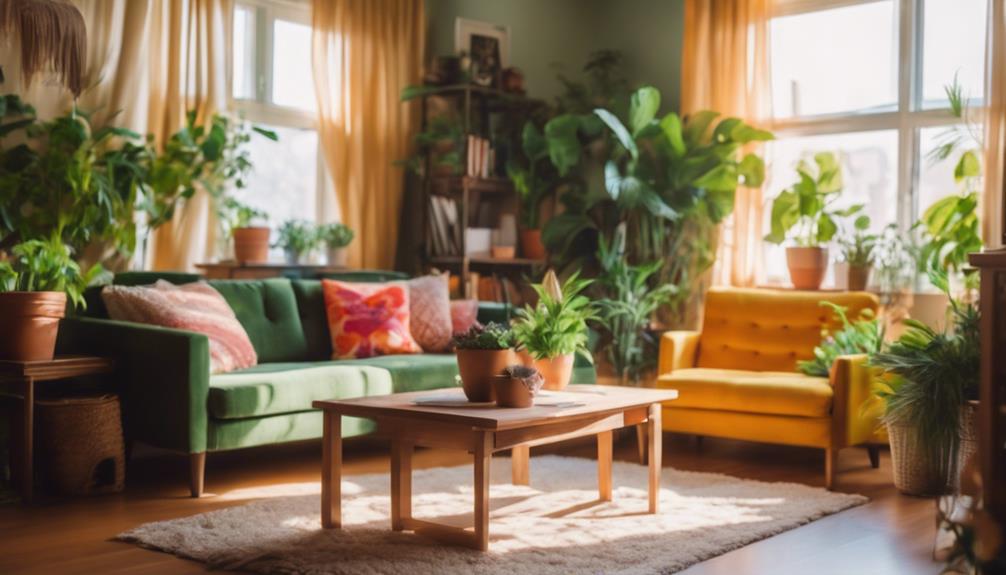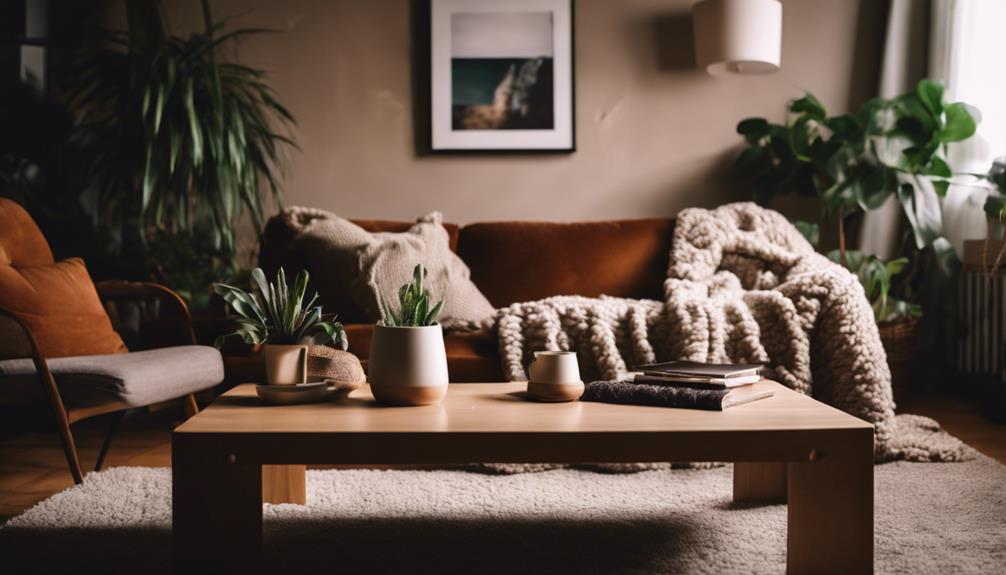To design a Scandinavian-inspired gallery wall without clutter, focus on a neutral color palette using whites, grays, and soft earth tones. Choose artwork with muted tones and natural frames to maintain cohesion. Incorporate floating wooden shelves for added function and allow easy rotation of art. Add geometric wall art and a stylish wire grid for a minimalist, modern touch. Use warm LED wall sconces or adjustable pendant lights for inviting illumination. Finally, include textured elements like woven hangings or vintage vases to add depth. Discovering the perfect balance in your design can transform your space even further. Consider adding indoor plants or botanical prints to bring the feeling of the Scandinavian outdoor space indoors. Utilize natural textures such as wool rugs and linen throw pillows to create a cozy and inviting atmosphere. Embrace the simplicity and functionality of Scandinavian design by incorporating multifunctional furniture pieces like a storage bench or a sleek side table. Bring in elements of nature, such as wood and stone, to create a harmonious connection between your indoor space and the Scandinavian outdoor environment.
Key Elements
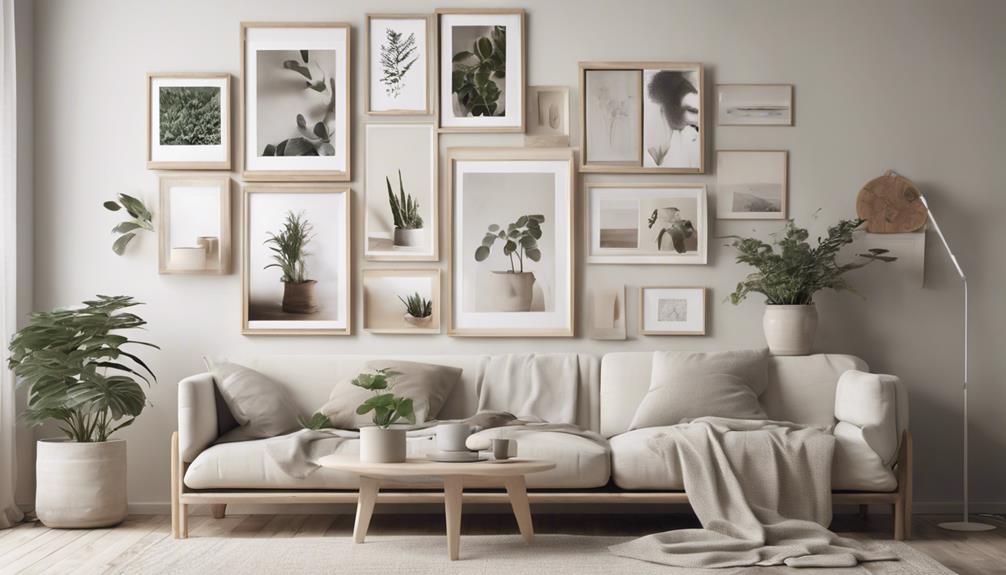
To create a stunning Scandinavian-inspired gallery wall, focus on color scheme, materials, and textures.
You'll want to embrace a neutral palette that enhances your artwork while choosing simple frames that reflect a minimalist style.
Color Scheme
A Scandinavian-inspired gallery wall often showcases a neutral color palette that includes whites, grays, and soft earth tones, creating a calming and cohesive atmosphere. To achieve this look, you should select artwork that features muted colors, like pastels or monochromatic tones. This choice maintains a minimalist aesthetic while still providing visual interest.
When planning your color scheme, aim for balance by mixing prints that incorporate subtle hints of complementary shades. This guarantees that no single piece dominates the visual space, allowing each artwork to shine. Limiting yourself to three to five pieces will help prevent clutter, emphasizing the beauty of each individual artwork.
As you choose frames, consider incorporating natural materials, like wooden frames in light or medium finishes. These choices enhance the organic feel of your gallery wall without overwhelming the overall design.
Materials
Selecting the right materials is essential for achieving that serene Scandinavian-inspired gallery wall you desire. Start with art prints that feature neutral and muted tones. These colors maintain a cohesive look and align perfectly with Scandinavian design principles.
When it comes to frames, opt for natural materials like wood or metal. Varying sizes can create visual interest without overwhelming the wall.
To enhance your gallery wall while keeping it minimal, incorporate simple decor elements. A few small plants or unobtrusive shelves can add character without clutter.
High-quality matting is another vital element. It showcases your wall art effectively, adding depth while avoiding distracting patterns or colors.
Textures
Incorporating various textures into your Scandinavian-inspired gallery wall not only enhances its organic feel but also adds depth and interest to the overall design.
Start with natural materials like wooden frames and canvas prints to establish a connection with nature. This foundation sets the stage for mixing textures that create visual intrigue.
Consider incorporating matte and glossy finishes in both your frames and artwork. This contrast enriches the overall aesthetic without overwhelming the space.
Textiles, such as fabric wall hangings or woven pieces, introduce warmth and softness, beautifully complementing the clean lines of minimalist art.
Don't forget to include tactile elements like metal accents or ceramic sculptures. These can elevate your design, providing a variety of surfaces that invite touch and curiosity.
Emphasizing a neutral color palette while layering textures helps maintain a serene and uncluttered look, which is essential in Scandinavian design.
Essential Fixtures and Furniture
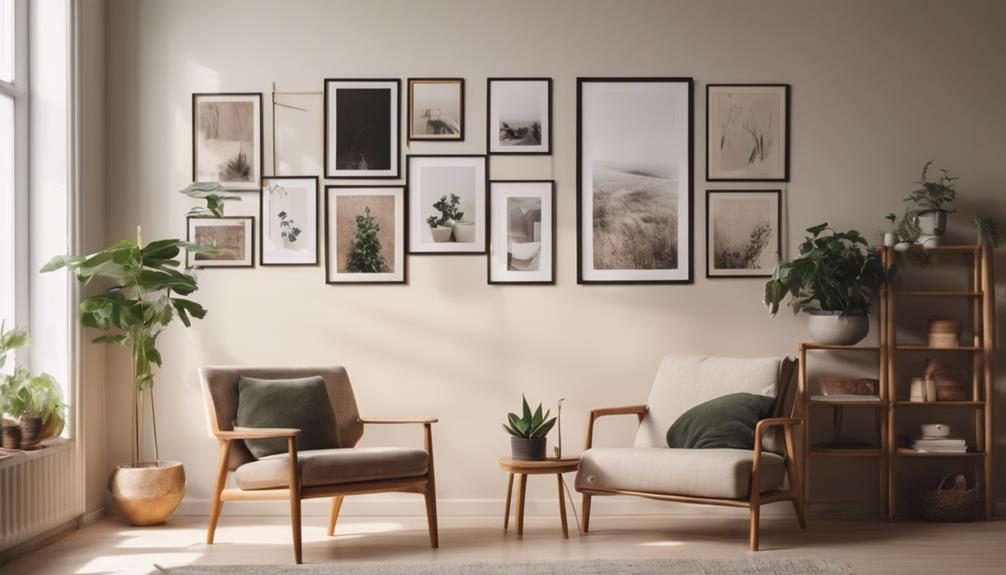
To enhance your Scandinavian-inspired gallery wall, consider incorporating essential fixtures like floating wooden shelves and a stylish wire wall grid.
These elements not only showcase your art but also add functional storage and a modern touch.
Geometric wall art displays can further elevate the aesthetic, creating a harmonious blend of style and practicality.
Floating Wooden Shelves
Floating wooden shelves transform your Scandinavian-inspired gallery wall into a functional and stylish display for art and personal treasures. These versatile shelves allow you to showcase framed prints, plants, and cherished mementos without sacrificing valuable floor space. You can install floating wooden shelves at varying heights to create visual interest and accommodate different artwork sizes, all while keeping the overall look clean and uncluttered.
Utilizing natural wood finishes aligns seamlessly with Scandinavian design principles, emphasizing simplicity and the beauty of organic materials. This not only enhances the warmth of your space but also provides a lovely contrast to minimalist decor.
Floating wooden shelves also offer a practical solution for rotating your art and decor, making it easy to refresh your gallery wall without extensive wall alterations.
Geometric Wall Art Display
Integrating geometric wall art into your Scandinavian-inspired gallery wall adds a modern touch while maintaining the clean lines and simplicity that define this design style. Focus on pieces that emphasize minimalism through clean lines and simple shapes, perfectly aligning with Nordic design principles.
Select a limited color palette featuring neutral tones like whites, grays, and soft pastels. This choice keeps your gallery walls cohesive and serene, enhancing the overall aesthetic. To further elevate your geometric art, consider using natural wood or metal frames, which highlight the Scandinavian emphasis on natural elements and textures.
When arranging your geometric artworks, opt for a balanced but asymmetrical layout. This approach creates visual interest without overwhelming your space—an essential aspect of Scandinavian design.
Additionally, think about incorporating floating shelves to showcase small geometric sculptures or plants. This not only adds depth and dimension to your gallery wall but also maintains an uncluttered look.
Stylish Wire Wall Grid
A stylish wire wall grid serves as a versatile and minimalist solution for showcasing your favorite art and decor, perfectly aligning with Scandinavian design principles. By mounting the grid directly on your wall, you create a clean, uncluttered look that emphasizes simplicity and functionality. This approach allows you to easily swap out pieces without needing additional wall fixtures, keeping your display fresh and dynamic.
Using clips or hooks, you can arrange smaller art pieces, photos, or decorative items organically on the grid. This flexibility helps avoid overcrowding while maintaining an airy feel in your space. The neutral colors of wire grids—often in black, white, or natural metal finishes—complement the serene color palettes typical of Nordic decor.
You might also consider incorporating plants or lightweight decorative objects onto the wire grid. This adds a touch of nature and warmth while enhancing the overall aesthetic of your wall. By embracing this stylish wire wall grid, you can create a Scandinavian-inspired gallery wall that reflects your personal style without the clutter.
It's a chic and functional way to elevate your home decor!
Lighting Ideas
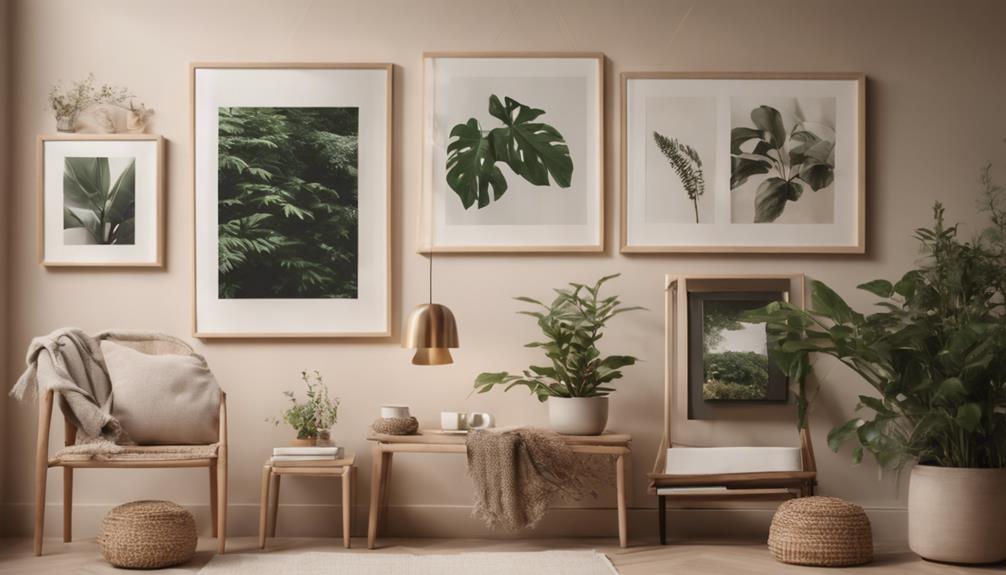
When it comes to lighting your Scandinavian-inspired gallery wall, think about soft pendant lights and warm LED wall sconces to create an inviting atmosphere.
You can also explore track lighting with dimmers for versatility and accent floor lamps to highlight specific pieces.
Each of these options can enhance your artwork while keeping the minimalist aesthetic intact.
Soft Pendant Lights
Soft pendant lights effortlessly enhance your gallery wall, bringing a warm, inviting glow that highlights your artwork beautifully. In Scandinavian design, these lights often feature minimalist shapes and neutral colors, making them the perfect complement to a clean aesthetic.
When you choose soft pendant lights, consider options that allow for adjustable heights. This flexibility creates layered lighting effects, which not only enhance visibility but also add depth to the space. Using warm white LED bulbs in your pendant lights can evoke a cozy ambiance, aligning perfectly with the Scandinavian focus on creating inviting home environments.
Hanging pendant lights at varying heights further contributes to visual interest, making your gallery wall feel dynamic and less cluttered. To harmonize with your decor, consider incorporating natural materials like wood or rattan in your pendant light designs. This not only emphasizes the organic elements of Scandinavian style but also fosters a cohesive connection between your lighting and artwork.
With thoughtful selection and arrangement, soft pendant lights won't only illuminate your gallery wall but also enhance the overall atmosphere of your space.
Warm LED Wall Sconces
Warm LED wall sconces create an inviting glow that perfectly complements your gallery wall while maintaining the minimalist charm of Scandinavian design. These sconces emit a soft light that enhances the overall ambiance without overwhelming your carefully curated art pieces.
By choosing warm LED wall sconces, you're also making an energy-efficient choice, as they last longer than traditional bulbs and support a sustainable lifestyle.
To maximize the impact of your gallery wall, consider placing the sconces at varying heights. This not only creates depth but also draws attention to specific artworks, adding visual interest. Look for sconces with sleek, simple designs that echo the clean lines and functional elegance of Nordic decor.
If you want versatility, opt for dimmable warm LED wall sconces. They allow you to adjust the brightness, setting the perfect mood for any occasion—be it a cozy gathering or a quiet evening of reflection.
With these thoughtful lighting choices, your gallery wall will shine beautifully, embodying the serene and inviting spirit of Scandinavian design.
Track Lighting With Dimmers
Adding track lighting with dimmers enhances your gallery wall by providing flexible illumination that highlights your favorite pieces while maintaining the minimalist vibe of Scandinavian design.
Track lighting allows you to position and direct light exactly where you need it, guaranteeing that each artwork stands out without overwhelming the space. This adaptability is essential for achieving the clean, uncluttered look typical of Scandinavian decor.
Using dimmers gives you control over the light intensity, allowing you to create a softer ambiance that aligns with the serene aesthetic of the style. You can easily adjust the brightness to suit different times of day or moods, making your gallery wall feel inviting and cozy.
Opting for energy-efficient LED track lighting not only reduces electricity consumption but also provides adequate illumination without casting harsh shadows. Incorporating warm white light, around 2700K, complements the natural materials and neutral color palettes found in Scandinavian design.
Plus, the ability to angle the track lighting ensures each piece is showcased effectively, enhancing visual interest and maintaining the overall minimalist appeal of your gallery wall.
Accent Floor Lamps
Accent floor lamps enhance your Scandinavian-inspired gallery wall by combining functionality with style, providing both illumination and a touch of artistic flair.
When choosing accent floor lamps, look for designs that feature clean lines and minimalistic forms, often crafted from wood and metal. This maintains the serene aesthetic typical of Scandinavian decor.
Opt for lamps in neutral colors or soft pastels to complement the calmness of your gallery wall without overwhelming the space.
Adjustable floor lamps serve a dual purpose as both functional lighting and art pieces, enhancing visual interest while highlighting specific artworks.
Incorporating lamps with dimmable features allows you to create versatile lighting options, establishing a cozy ambiance that contributes to the tranquility of your decor.
Strategic positioning of accent floor lamps near the gallery wall can draw the eye and create focal points, ensuring your art pieces shine in their best light.
With the right accent floor lamps, you'll not only illuminate your artwork but also enhance the overall aesthetic of your Scandinavian-inspired gallery wall, achieving a harmonious balance of light and design.
Decorative Elements
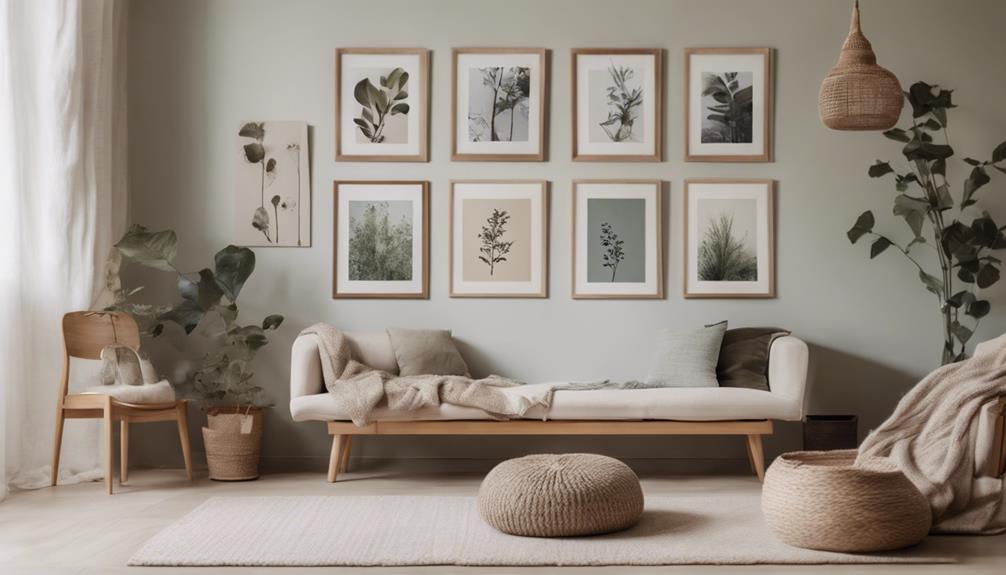
When you think about decorative elements for your Scandinavian-inspired gallery wall, consider incorporating a vintage ceramic vase, a framed botanical print, and a textured woven wall hanging.
These pieces not only add character but also resonate with the natural and minimalist aesthetic that defines Scandinavian design.
Vintage Ceramic Vase
Vintage ceramic vases effortlessly enhance the charm of a Scandinavian-inspired gallery wall, introducing texture and character while maintaining the minimalist aesthetic. These vases can serve as eye-catching decorative elements without overwhelming your space. To keep with the Scandinavian theme, opt for vases in neutral or muted tones. This choice guarantees that the artwork remains the focal point.
Incorporating varying heights and shapes of vintage ceramic vases creates visual interest and depth, complementing the art pieces displayed around them. Position your vases strategically within the arrangement to balance the composition and break up any visual monotony. This intentional design flow promotes a cohesive look.
You might also consider using vintage ceramic vases as functional decor. Filling them with simple greenery or dried flowers enhances the organic feel typical of Nordic interiors. This not only adds life to your gallery wall but also reinforces the minimalist aesthetic.
Framed Botanical Print
Framed botanical prints add a touch of nature to your Scandinavian-inspired gallery wall, promoting a calming and organic aesthetic. To maintain a cohesive look, opt for prints featuring neutral and muted tones like soft greens and earthy browns. These colors align beautifully with minimalist Scandinavian design principles, creating an uncluttered environment.
When choosing frames, consider natural materials such as wood. This enhances the warmth and texture of the botanical prints while reinforcing the serene atmosphere you're aiming for.
For the layout, arrange your botanical prints in a varied yet balanced manner. Keep consistent spacing of 2-3 inches between frames to avoid a crowded appearance, allowing each piece to shine.
Mixing sizes and orientations of the framed botanical prints can also create visual interest and depth, enhancing the overall impact of your gallery wall without overwhelming the space.
Textured Woven Wall Hanging
A textured woven wall hanging adds warmth and depth to your Scandinavian-inspired gallery wall, perfectly complementing the minimalist aesthetic.
These textured woven wall hangings are a hallmark of Scandinavian design, effortlessly enhancing the overall ambiance without overwhelming it. By utilizing natural materials like cotton, wool, or jute, they align with the Nordic emphasis on sustainability and organic textures.
When you choose neutral color palettes for your woven hangings, you guarantee they blend seamlessly into various decor styles, maintaining a soothing visual impact. This allows you to create a cohesive look while adding an interesting tactile element.
These hangings can serve as focal points on your wall or complement other art pieces, providing that much-needed contrast that enriches your gallery wall's appeal.
One of the best aspects of textured woven wall hangings is their lightweight nature, which makes installation and repositioning a breeze. You can easily refresh your gallery wall layout without the risk of clutter.
Incorporating these decorative elements not only elevates your space but also embodies the essence of Scandinavian design—simple, functional, and beautiful.
Flooring
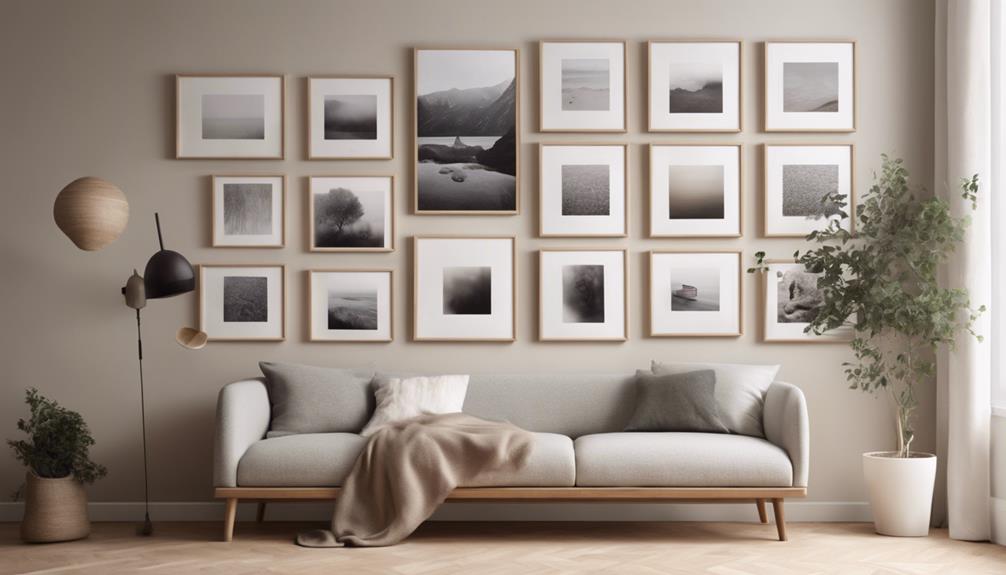
When you're considering flooring for your Scandinavian-inspired gallery wall, light ash wood planks can create an airy atmosphere that complements your artwork beautifully.
Reclaimed oak wide plank flooring adds a rustic touch while maintaining the minimalist vibe.
Natural bamboo flooring is another great option, offering warmth and sustainability that aligns perfectly with Nordic design principles.
Light Ash Wood Planks
Light ash wood planks offer a durable and stylish flooring option that perfectly complements Scandinavian-inspired decor. Known for their resistance to wear, these planks are ideal for high-traffic areas in your home. The natural light color enhances the brightness of your space, adhering to the Scandinavian principle of creating airy, open environments.
With their fine grain and smooth texture, light ash wood planks contribute to a minimalist aesthetic, providing a subtle yet sophisticated backdrop when you create a gallery wall. The versatility of these planks allows you to seamlessly integrate various art styles and colors into your space without overwhelming it.
Furthermore, using light ash wood is an environmentally friendly choice, as it comes from fast-growing trees, aligning with eco-conscious Scandinavian decor. This sustainable flooring option not only beautifies your home but also supports responsible sourcing practices.
Reclaimed Oak Wide Plank Flooring
Reclaimed oak wide plank flooring offers a sustainable and visually striking alternative that brings rustic charm and character to your Scandinavian-inspired home. Sourced from salvaged wood, this eco-friendly option not only enhances the aesthetic appeal but also aligns with your desire for a sustainable lifestyle.
The wider planks, typically ranging from 6 to 12 inches, create an open and spacious feel, making your space look larger and more inviting.
Each piece of art that's your flooring showcases unique natural variations in color and grain patterns, ensuring that no two floors are exactly alike. This individuality adds character, allowing your home to reflect your personal style.
Known for its durability and strength, reclaimed oak can withstand heavy foot traffic, making it an ideal choice for both residential and commercial spaces.
Natural Bamboo Flooring
Natural bamboo flooring consistently stands out as a sustainable and stylish choice for those looking to enhance their Scandinavian-inspired spaces. Its eco-friendly nature stems from bamboo's rapid growth and renewability, making it an excellent flooring option for the environmentally conscious.
You'll appreciate its impressive durability, as natural bamboo flooring boasts a hardness rating comparable to hardwoods like oak. This means it can withstand daily wear and tear while maintaining its beauty.
When it comes to aesthetics, bamboo flooring offers a variety of styles—vertical, horizontal, and strand-woven—allowing you to choose the perfect look that complements your minimalist design. The natural light tones and clean lines align seamlessly with the Scandinavian decor principles, promoting a serene and uncluttered environment.
Caring for your natural bamboo flooring is straightforward. Regular sweeping or vacuuming, along with occasional damp mopping, will keep it looking fresh and vibrant.
Conclusion
Creating a Scandinavian-inspired gallery wall can transform your space into a serene and stylish retreat.
By focusing on key elements, choosing essential fixtures, and incorporating thoughtful lighting, you'll achieve a clean yet inviting look.
Remember to select decorative elements that resonate with you while maintaining a sense of balance.
With the right flooring to complement your design, you'll enjoy a clutter-free gallery wall that reflects your personal style and enhances your home's aesthetic.

